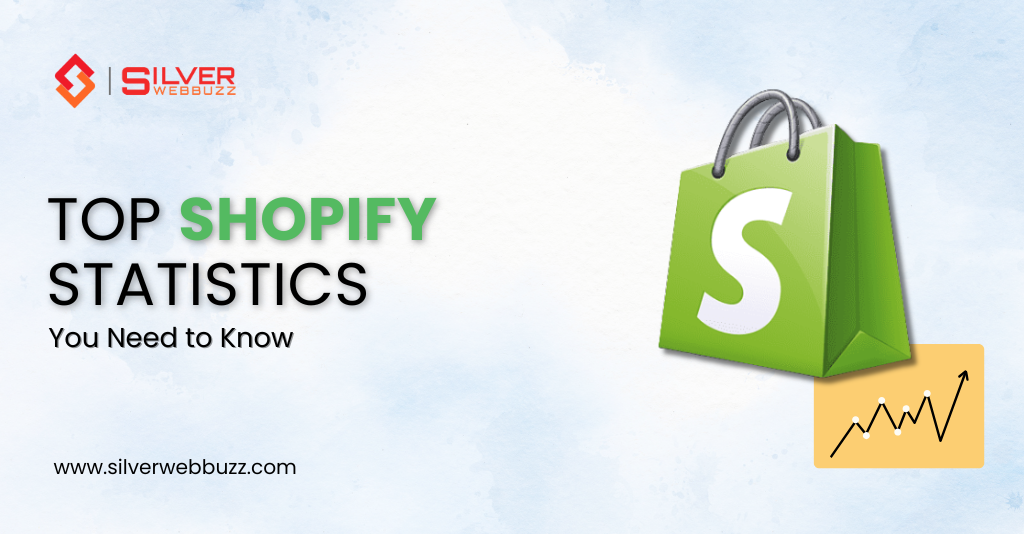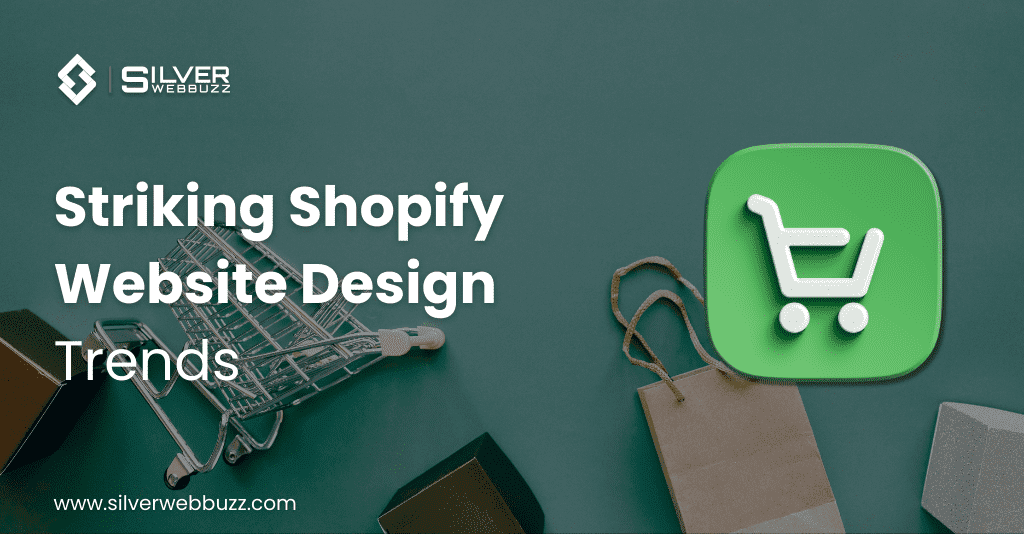Shopify has become a dominant force in the global eCommerce industry, empowering millions of merchants to build, manage, and scale their online stores. Known for its ease of use and robust features, it continues to grow rapidly, attracting businesses of all sizes. In 2025, the platform marked a breakthrough year, expanding its global reach, merchant base, and third-party integrations like never before.
Understanding Shopify stats is crucial for store owners, marketers, and developers alike. These insights enable the tracking of performance, identification of trends, and informed decision-making that drive business growth. Whether it’s analyzing conversion rates, average order value, or customer behavior, stats provide a clear picture of what’s working and what needs improvement.
For developers, Shopify stats reveal integration opportunities, while marketers rely on them to optimize campaigns and boost ROI. With 2025 setting new records in user engagement and revenue, tracking stats has never been more important. As the platform continues to evolve, staying informed through reliable stats will help businesses remain competitive and future-ready in the ever-changing eCommerce landscape.
Shopify Growth Trends
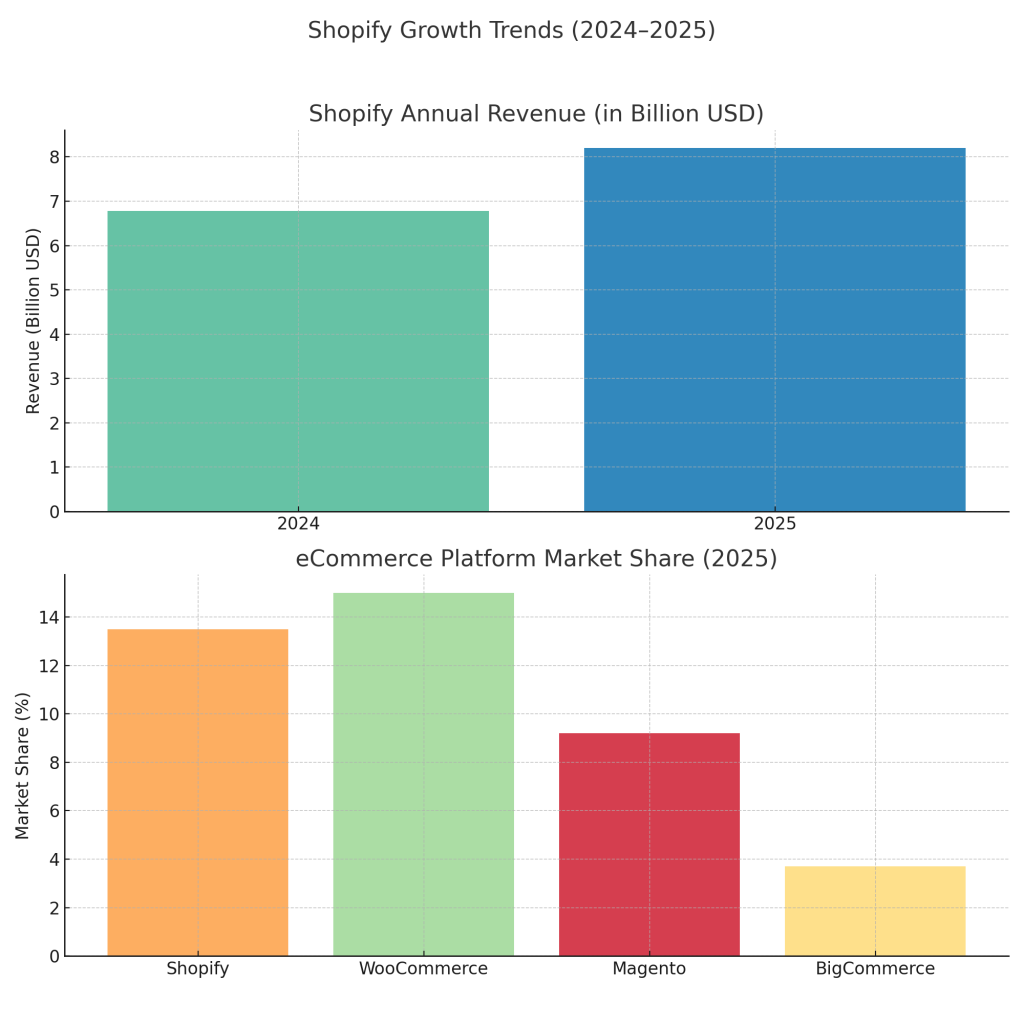
The Shopify growth trends from 2024 to 2025 highlight the platform’s continued rise as a global eCommerce leader. As of mid-2025, Shopify reported $8.2 billion in annual revenue, reflecting a 21% year-over-year increase from 2024. This surge solidifies Shopify’s position among the top three eCommerce platforms worldwide, alongside WooCommerce and Magento.
Shopify currently powers over 4.8 million live stores globally, with more than 700,000 new merchants joining the platform in the past year alone. These figures contribute to Shopify holding approximately 13.5% of the global eCommerce platform market share, ahead of BigCommerce and closing in on WooCommerce, which holds around 15%.
One of the most notable Shopify growth trends is its increasing adoption among enterprise-level businesses and DTC (direct-to-consumer) brands. With tools like Shopify Plus and integrations with global logistics networks, larger merchants are turning to Shopify for scalability and ease of use.
Shopify Usage by Country
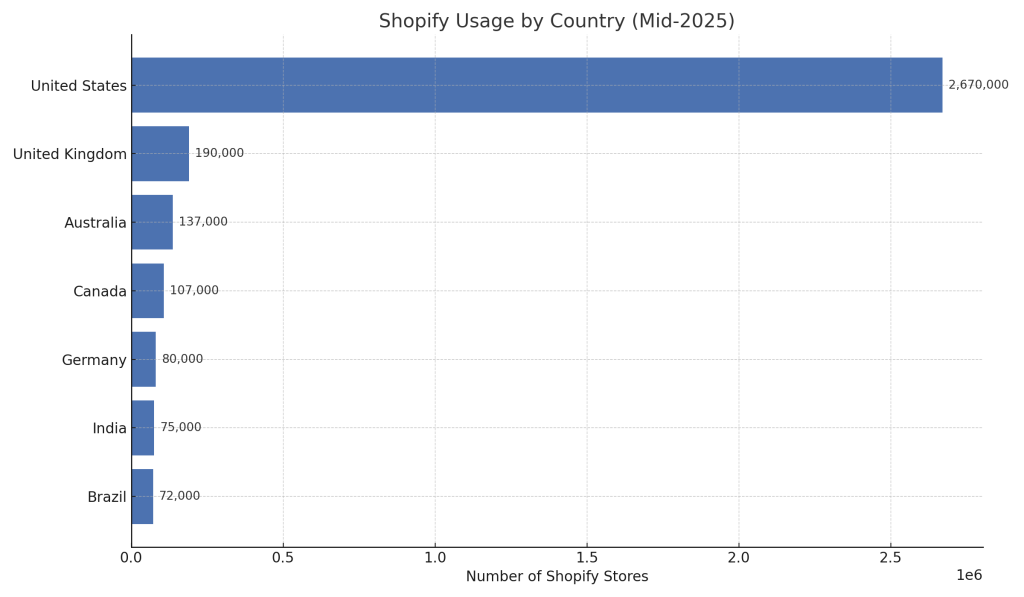
As of mid-2025, its global reach is undeniable, with its platform powering millions of online stores across a variety of countries. Shopify usage by country is heavily concentrated in certain key regions, which drive the platform’s overall growth and market dominance.
The United States leads the pack by a significant margin. It is home to over 2.67 million Shopify stores, making it the top country for usage. This accounts for more than half of the platform’s global merchant base and demonstrates the strong entrepreneurial spirit and robust e-commerce ecosystem in the US.
Following the US, other top countries where Shopify stores are located include the United Kingdom, with over 190,000 stores, and Australia, with more than 137,000 stores. Canada, the home country, also maintains a strong presence with over 107,000 stores. Other notable countries with a significant number of its merchants include Germany, India, and Brazil.
In terms of growth rate, while North America remains the largest market, Shopify is seeing accelerated expansion in other regions. In its Q2 2025 financial results, it reported that revenue growth rates were accelerating not only in North America but also in Europe and the Asia Pacific region, indicating a growing global footprint. The company’s strategic focus on international markets, offering localized tools and services, is a key driver of this regional growth.
Top-Level Domain Distribution for Shopify Stores
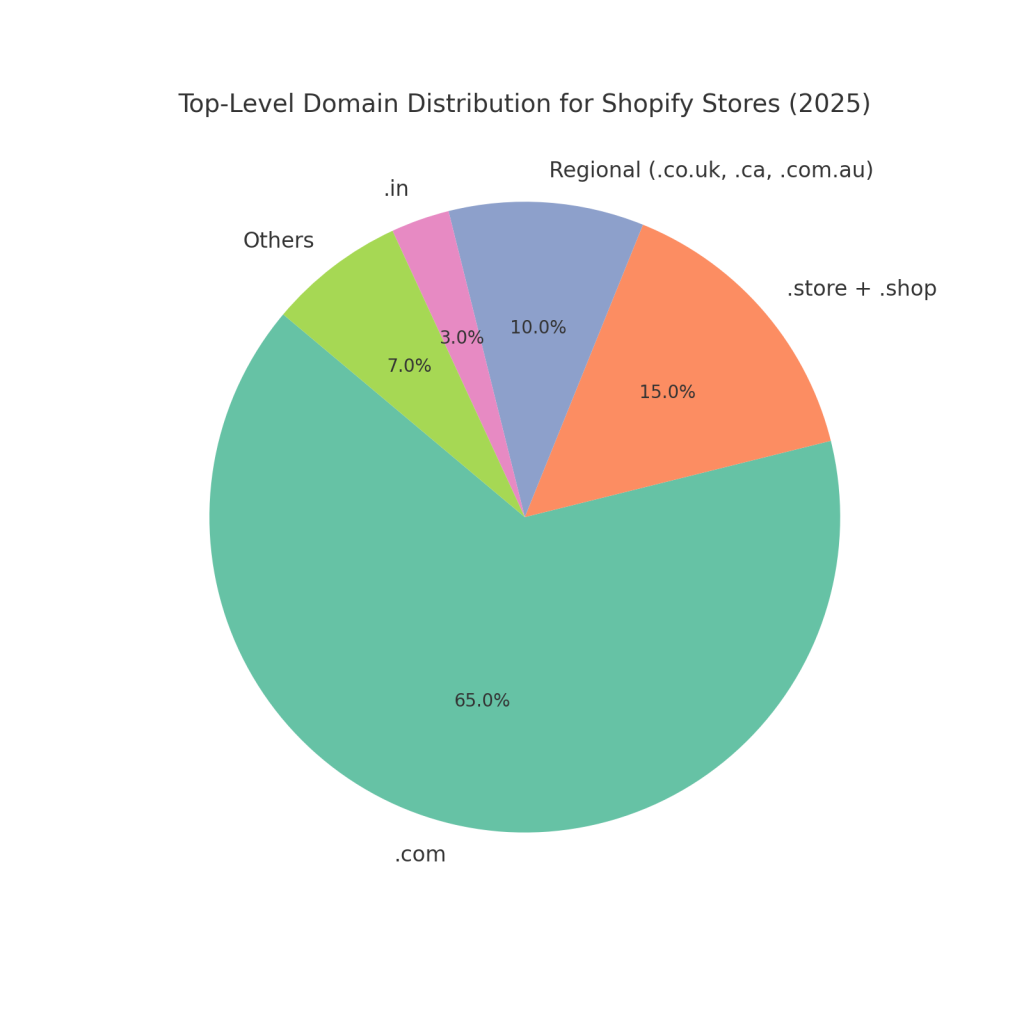
When analyzing Shopify stats, one fascinating aspect is the distribution of top-level domains (TLDs) used by stores across the platform. As of 2025, .com remains the dominant choice, with over 65% of stores preferring this globally recognized extension due to its credibility and brand trust.
Other popular domains include .store and .shop, collectively used by around 15% of merchants. These ecommerce-specific TLDs have gained popularity for their relevance and availability. Regional domains like .co.uk, .ca, and .com.au are widely adopted in their respective countries, making up nearly 10% of domain usage.
In markets like India, the use of .in is steadily growing, accounting for approximately 3% of all domains. This highlights a clear trend toward geo-targeted domain usage, allowing brands to localize their presence and better connect with regional audiences.
As ecommerce expands globally, the diversity in domain selection reflects the evolving strategies of merchants aiming for both international reach and local relevance. Choosing the right domain extension is now a strategic part of brand identity and SEO optimization.
Social Media Usage by Shopify Stores
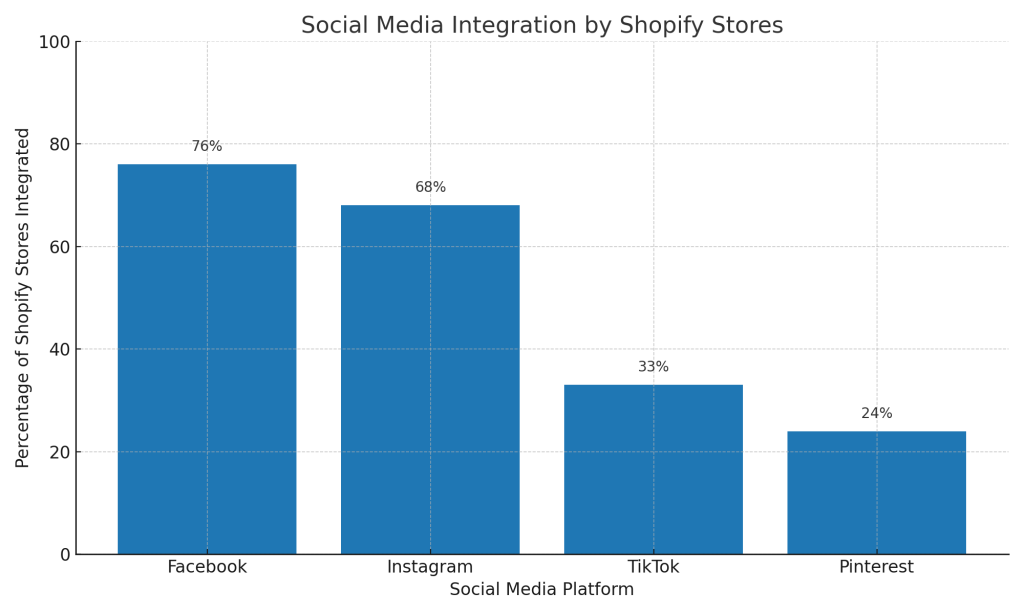
Social media plays a critical role in the growth of ecommerce, and Shopify stores are leveraging it like never before. According to recent Shopify stats, over 76% of merchants have integrated their stores with Facebook, while 68% use Instagram Shopping to promote and sell products directly through social feeds. TikTok has rapidly gained traction, with around 33% of stores now connected, thanks to its powerful algorithm and younger audience base. Meanwhile, Pinterest integration is seen in 24% of stores, particularly in niches like fashion, home décor, and DIY.
Social commerce is becoming a major revenue driver. Shopify reports that merchants using integrated social channels see a 20-30% increase in conversion rates compared to those who don’t. Instagram and Facebook remain the top-performing platforms for Shopify sales, but TikTok is showing the fastest growth in engagement and ROI, especially for Gen Z-focused brands.
With evolving algorithms and new shopping features, social media is no longer just a marketing tool—it’s a fully functional sales channel for Shopify merchants, shaping the future of ecommerce.
Contact Information Availability on Shopify Stores
One of the critical factors influencing buyer trust is the visibility of contact information on Shopify stores. According to recent Shopify stats, around 68% of stores prominently display some form of contact detail on their website. This transparency helps improve customer confidence and reduces cart abandonment rates.
The most common contact methods include email (used by 52% of stores), followed by contact forms (38%), phone numbers (19%), and WhatsApp or chat integrations, which are growing in popularity, now used by over 12% of merchants. Stores that offer multiple contact channels often experience higher customer retention and satisfaction scores.
Accessible contact information on stores is more than just a convenience—it’s a conversion tool. A store with clearly listed contact details is 40% more likely to convert first-time visitors compared to those without. Moreover, it significantly boosts a brand’s credibility and professionalism.
Number of Employees for Shopify Stores
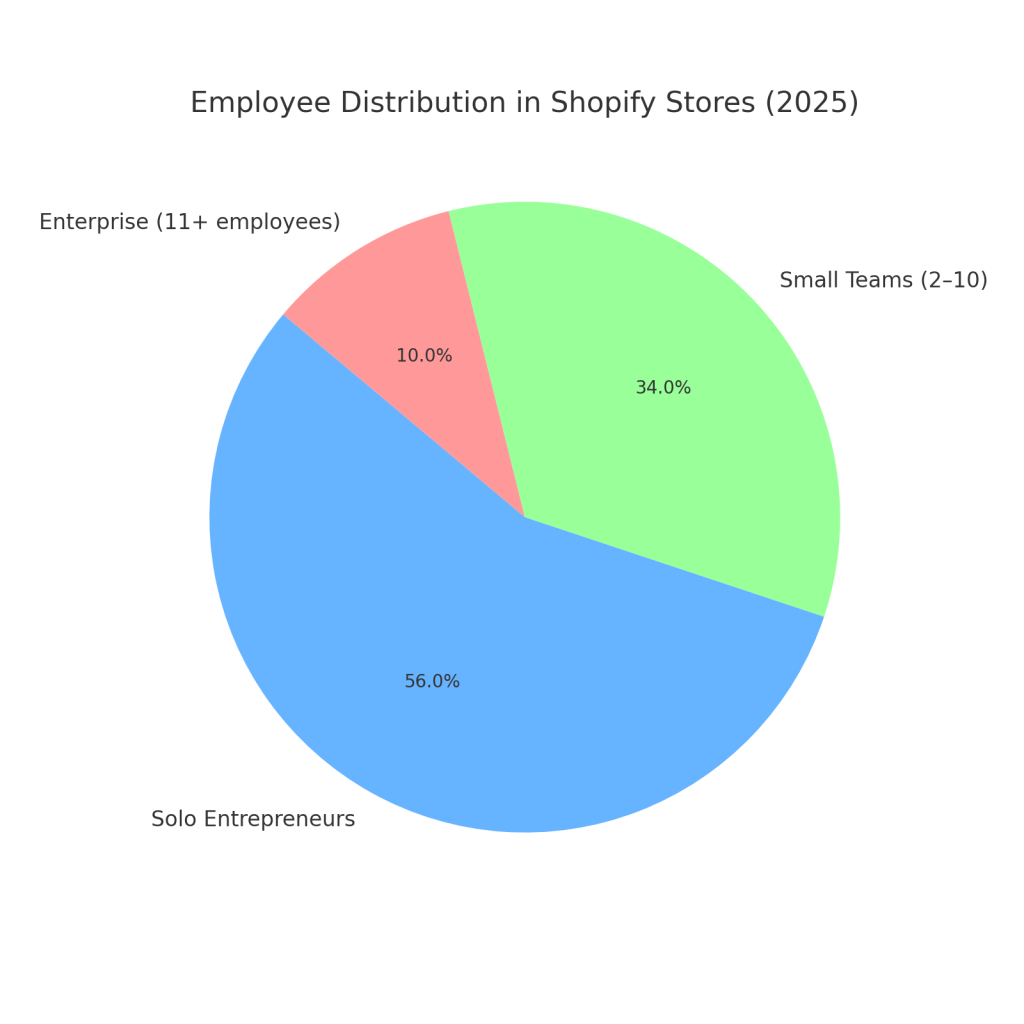
Understanding the number of employees for Shopify stores offers valuable insights into store scale, operational capacity, and growth potential. In 2025, stores can be broadly categorised into three types based on team size: solo entrepreneurs (approximately 56%), small teams with 2–10 employees (34%), and enterprise-level businesses with 11 or more employees (10%).
Interestingly, while solo-run stores make up the majority, stores with small teams or larger staff often outperform in revenue and customer experience. Data shows that stores with 5–10 employees experience up to 2.5 times higher average monthly sales than solo-run counterparts, due to better resource allocation, effective marketing execution, and enhanced customer support.
The employee growth rate among Shopify businesses has been steadily increasing. Between 2023 and 2025, there’s been a 19% rise in stores hiring additional team members, reflecting the platform’s scalability and the success of growing brands.
As more entrepreneurs scale their operations, tracking the number of employees for Shopify stores is an essential metric in understanding ecommerce business maturity and overall performance.
Number of Products Sold on Shopify Stores

The number of products sold on Shopify stores varies widely based on business model, niche, and target audience. As of 2025, the average store lists between 25 to 100 products, with many small to mid-sized stores focusing on curated collections to maintain quality and manageability.
Categories with the highest product inventory include fashion and apparel, home décor, and electronics—some of which have over 1,000 SKUs due to size, color, and variant options. Fashion alone accounts for more than 29% of stores, many of which offer extensive catalogs to meet diverse customer preferences.
A growing trend is the rise of multi-product vs. single-product stores. While single-product stores remain popular for dropshipping and niche marketing, multi-product stores have experienced a 21% growth since 2023, driven by customer demand for variety and enhanced cross-selling potential.
Tracking the number of products sold in stores provides insights into inventory strategies and business scalability, helping merchants decide between depth (focused SKUs) and breadth (wide inventory) based on their goals and market.
Top Technologies Used by Shopify Stores
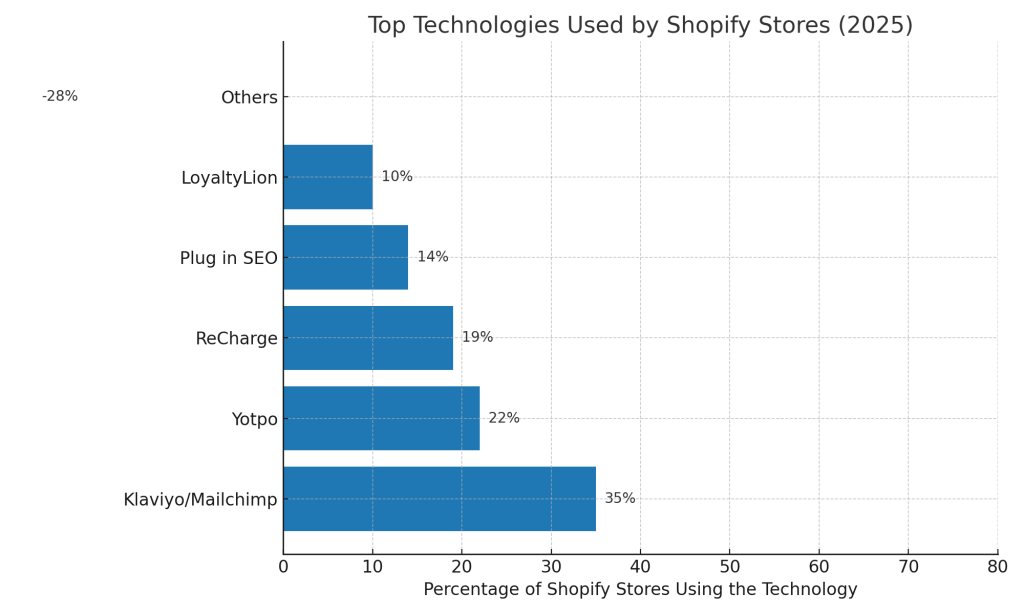
The top technologies used by Shopify stores play a critical role in enhancing performance, customer engagement, and sales growth. In 2025, over 72% of merchants actively integrate third-party tools to optimize their operations. Leading the pack are marketing and automation platforms like Klaviyo and Mailchimp, which power email campaigns for more than 35% of stores. Yotpo is widely adopted for user-generated reviews, while ReCharge dominates the subscription space with a 19% usage rate among recurring revenue models.
Merchants also rely heavily on SEO apps, loyalty programs, and retargeting tools. Apps like Plug in SEO and LoyaltyLion are among the top choices for driving organic traffic and building customer retention. As personalization becomes more critical, these technologies are proving essential for long-term growth.
Another major trend is the rise of headless commerce on Shopify. More enterprise-level brands are adopting this flexible approach to separate the front end from the back end, improving site speed and custom experiences.
Top Shopify Apps Used by Merchants
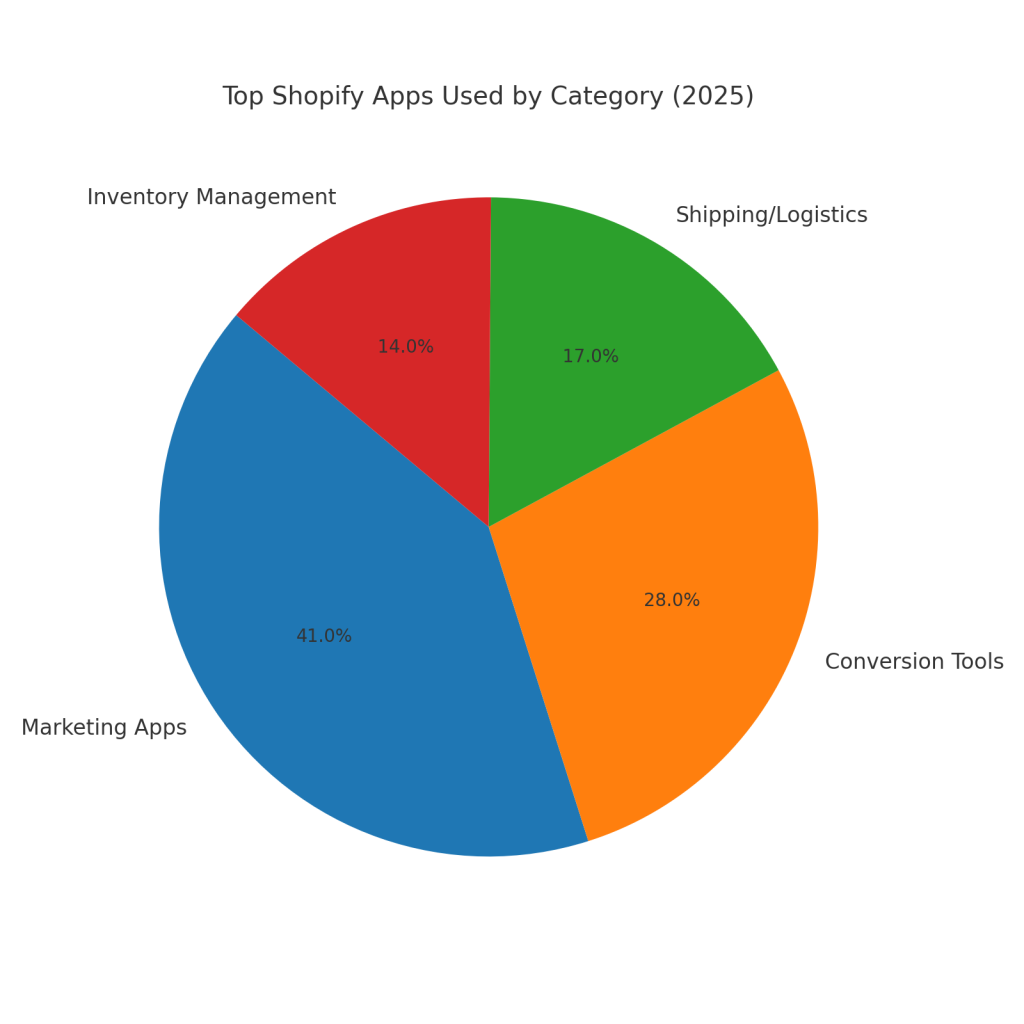
The top Shopify apps used by merchants play a crucial role in enhancing store performance, streamlining operations, and boosting customer engagement. In 2025, data shows that the average Shopify store uses 6 to 10 apps, with some high-performing stores using even more to fine-tune their workflows.
The most installed apps across Shopify stores include Klaviyo (for email marketing), Privy (conversion pop-ups), Oberlo (product sourcing), Judge.me (reviews), and Shopify Email. These tools help automate tasks and improve user interactions, making them must-haves for many merchants.
When broken down by category, marketing apps are the most used (41%), followed by conversion tools (28%), shipping/logistics (17%), and inventory management (14%). These solutions are key to increasing efficiency and providing seamless shopping experiences.
Using the top Shopify apps used by merchants has a measurable impact—stores that implement marketing and conversion apps report a 25% to 40% increase in sales and a significant improvement in customer retention. For merchants, choosing the right app stack is no longer optional—it’s a growth necessity.
Top Shipping Carriers Used by Shopify Stores
Shipping is a core part of ecommerce success, and the top shipping carriers used by Shopify stores reflect a mix of speed, reliability, and global reach. In 2025, the most commonly integrated carriers include USPS, UPS, FedEx, and DHL, with USPS leading among U.S.-based merchants due to affordability and wide coverage. UPS and FedEx are preferred for express and international deliveries, while DHL dominates in cross-border shipping, especially for European and Asian markets.
Region-specific trends show that Canada Post, Royal Mail, and Australia Post are widely used by merchants operating in those regions. native carrier integrations make it easy for store owners to offer real-time rates, label printing, and tracking updates.
Additionally, the use of third-party shipping and fulfillment apps has surged. Tools like ShipStation, Easyship, and AfterShip are now used by over 30% of merchants, helping automate multi-carrier logistics and improve shipping efficiency.
Top Shopify Stores Globally
The top Shopify stores globally are setting benchmarks in ecommerce with high traffic, strong branding, and exceptional user experience. In 2025, some of the highest-performing stores include Gymshark, Allbirds, Kylie Cosmetics, Fashion Nova, and ColourPop—each generating millions in monthly revenue and attracting millions of unique visitors.
A breakdown by industry shows that fashion and apparel, beauty and cosmetics, and health and fitness dominate the leaderboard. For instance, Gymshark, in the fitness apparel space, sees over 10 million visits per month, while Kylie Cosmetics remains a powerhouse in beauty, leveraging influencer marketing and product drops.
What sets these top stores globally apart is a mix of high-end design, seamless UX, and data-driven product strategies. Their websites are optimized for mobile, have fast load times, and feature personalized shopping experiences—all critical for boosting conversions and retention.
New Shopify Stores
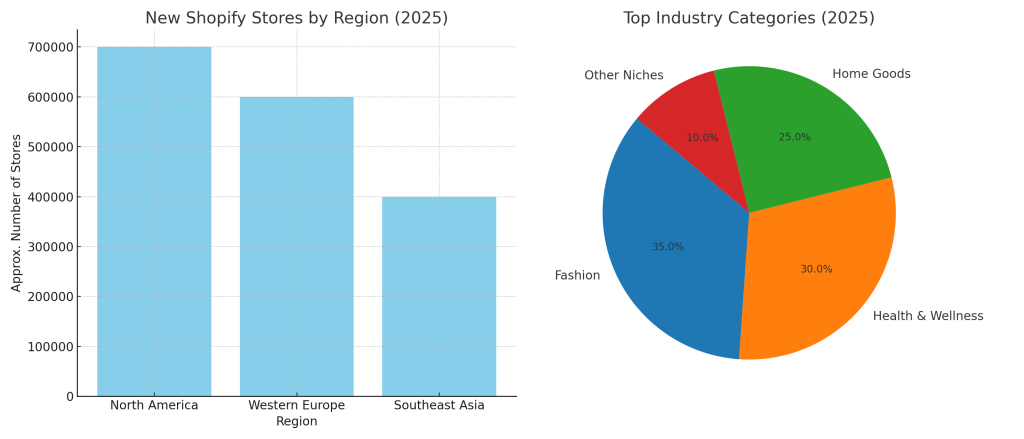
The surge in new Shopify stores highlights the platform’s growing appeal among entrepreneurs and direct-to-consumer (D2C) brands. In 2025, Shopify continues to see strong growth, with over 1.9 million new stores launched globally in the past 12 months—an increase of 16% year-over-year. This growth reflects the rising demand for flexible, scalable ecommerce solutions.
Regions leading in new store registrations include North America, Western Europe, and Southeast Asia, driven by a mix of startup-friendly ecosystems and increasing internet penetration. Industry-wise, fashion, health & wellness, and home goods remain dominant categories, with sustainable and niche product lines gaining traction fast.
The success of new stores is largely due to a robust ecosystem—offering everything from easy-to-use templates and payment integration to advanced apps for marketing, fulfillment, and analytics. This accessibility empowers even non-technical founders to launch, scale, and manage their brands efficiently.
Stores Switching to Shopify from Other Platforms
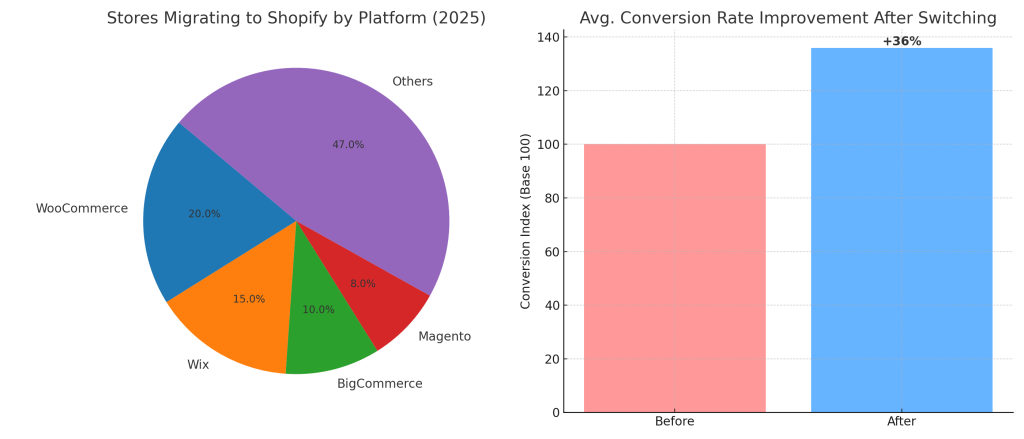
In recent years, there has been a significant surge in the number of stores switching to Shopify from other platforms, highlighting the platform’s growing dominance in the eCommerce space. As of 2025, over 4.8 million live websites are powered by Shopify globally, and thousands of merchants are migrating every month from platforms like WooCommerce, Wix, BigCommerce, and Magento.
Shopify has seen the highest conversion rate increase among platforms after migration—up to 36% on average—which is a strong driver for this shift. Many brands cite scalability, an extensive app ecosystem, and user-friendliness as key reasons for the transition. Robust infrastructure supports businesses from startup to enterprise level, making it an ideal choice for growing brands.
Notably, more than 35% of new stores in the last year came from WooCommerce and Wix alone. native features, combined with powerful integrations like Payments, Shop Pay, and a customizable front-end, offer merchants a seamless and profitable selling experience.
Stores Switching from Shopify to Other Platforms
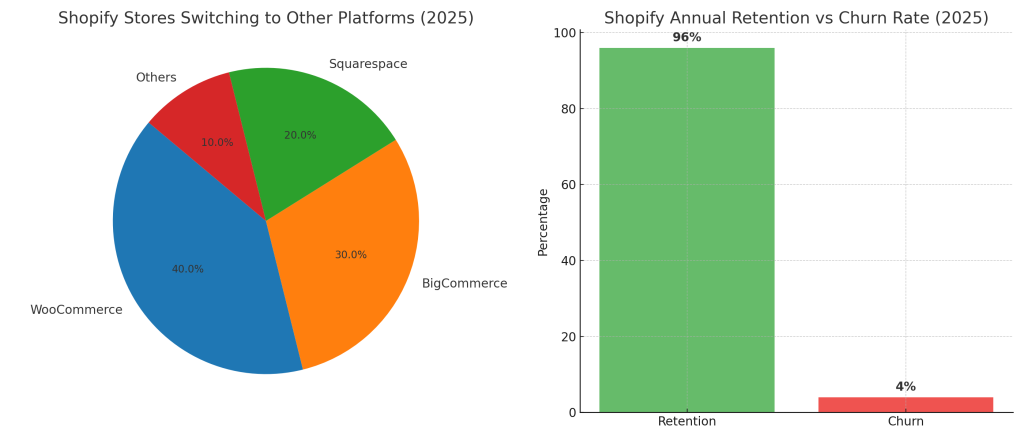
While Shopify continues to dominate the eCommerce landscape, a small percentage of stores switching from Shopify to other platforms does occur. According to recent 2025 data, around 2.5% to 3.2% of merchants migrate annually to platforms like WooCommerce, BigCommerce, and Squarespace.
This churn, though relatively low, is driven by several factors. One of the primary reasons is pricing flexibility—some merchants find monthly fees, transaction costs, and paid apps less cost-effective as they scale. Others move due to the need for more customization or open-source control, which WooCommerce (built on WordPress) readily offers.
In particular, BigCommerce attracts brands needing enterprise-level B2B features and greater backend flexibility. WooCommerce draws in users who are already embedded in the WordPress ecosystem or seek total control over their store infrastructure.
Even with these migrations, the volume of stores switching from Shopify remains minor compared to the influx it receives, indicating that retention rate is among the best in the industry—estimated at over 96% annually.
Mobile Commerce on Shopify
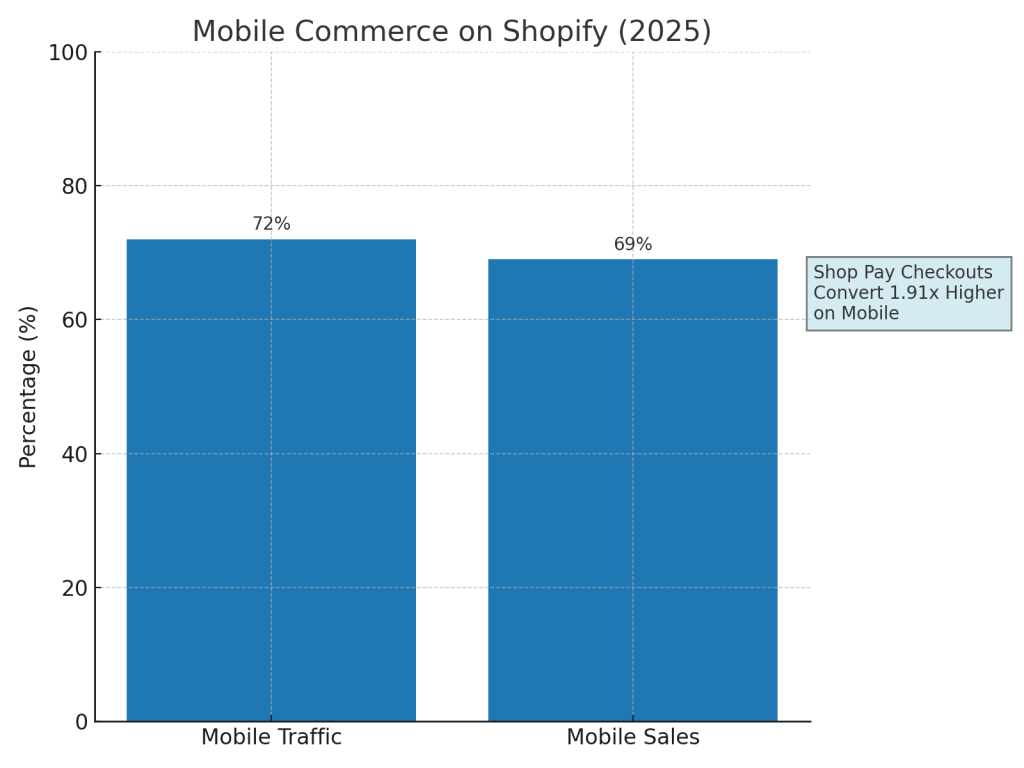
Mobile commerce on Shopify has seen explosive growth, becoming a central focus for merchants worldwide. As of 2025, over 72% of all traffic and 69% of total sales on stores come from mobile devices, reflecting the shift in consumer behavior toward mobile shopping.
To stay competitive, Shopify merchants are heavily investing in mobile optimization strategies. This includes adopting mobile-first themes, faster-loading storefronts, and touch-friendly navigation. The theme library now offers more than 80% mobile-optimized themes, helping store owners ensure a seamless experience across devices.
In addition, there’s been a sharp rise in the use of mobile apps like Shop Pay, which speeds up checkout and improves conversion rates. Reports show that Shop Pay checkouts convert up to 1.91x higher on mobile compared to standard checkouts.
With mobile commerce on Shopify continuing to lead eCommerce trends, merchants who prioritize mobile usability are seeing stronger engagement and higher sales performance. The mobile-first future isn’t coming—it’s already here.
Shopify in the AI & Automation Era
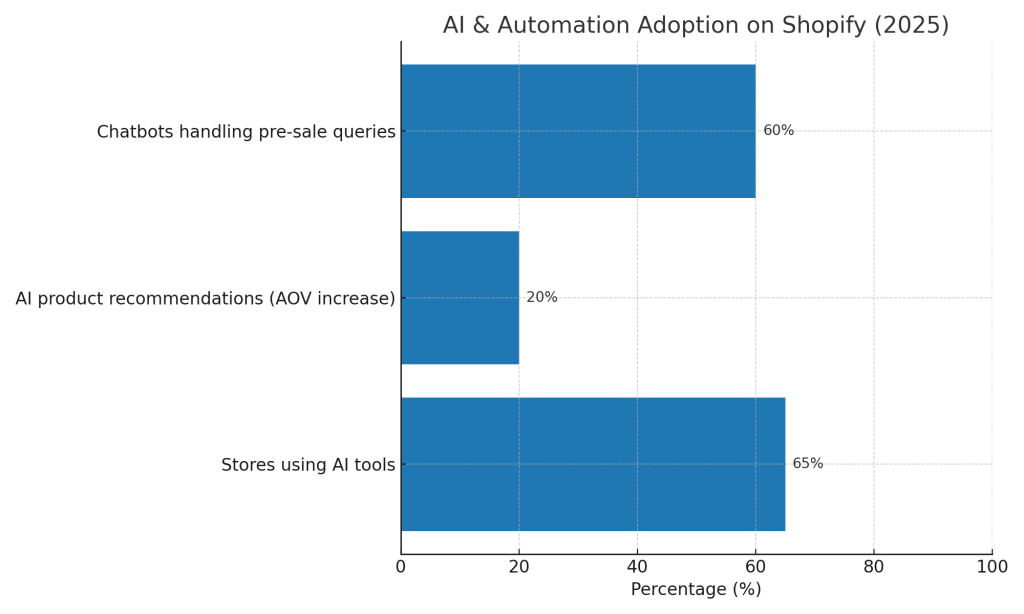
The rise of Shopify in the AI & automation era is revolutionizing how merchants operate their online stores. As of 2025, more than 65% of stores actively use at least one AI-powered tool to enhance their customer experience and streamline business operations.
Popular implementations include AI-driven product recommendations, which increase average order value by up to 20%, and chatbots, which now handle over 60% of pre-sale queries on stores, reducing response times and boosting customer satisfaction. Additionally, automated marketing tools like Klaviyo and Omnisend help store owners send personalized emails and SMS campaigns at scale—powered by machine learning algorithms that optimize send times and content.
Looking ahead, the future of AI in Shopify eCommerce includes predictive analytics, smart inventory management, and AI-generated product descriptions. commitment to integrating AI—especially through tools like Shopify Magic—is set to empower even small businesses with enterprise-grade automation.
Sustainability Trends Among Shopify Stores

Sustainability trends among Shopify stores are rapidly gaining momentum as consumers become more eco-conscious. In 2025, over 38% of merchants now sell products that fall under eco-friendly niches, such as reusable home goods, organic skincare, and zero-waste accessories.
Many stores are also embracing sustainable packaging—including biodegradable mailers, recycled materials, and plastic-free shipping options. According to Shopify data, over 55% of merchants have adopted at least one environmentally friendly operational practice, reflecting a growing commitment to ethical commerce.
Shopify itself supports this shift through features like the Shopify Planet app, which enables merchants to offer carbon-neutral shipping. Additionally, Shopify has pledged to power its platform with 100% renewable energy and provides tools to help stores track and offset their carbon footprint.
These collective efforts show that sustainability trends among stores are not just a passing movement—they’re becoming a core part of modern eCommerce values, helping brands align with eco-conscious customers while building long-term trust.
Build Your Shopify Website With Silver WebBuzz
If you’re ready to launch or scale your eCommerce brand, there’s no better time to build your website with Silver WebBuzz, a leading Shopify store development company trusted for creating high-performing online stores. With deep expertise in the eCommerce ecosystem, Silver WebBuzz helps brands grow smarter and faster.
Our team specializes in custom store design, development, SEO optimization, app integration, and ongoing technical support. Whether you’re migrating from another platform or starting fresh, we deliver pixel-perfect storefronts and seamless user experiences that drive results.
What sets Silver WebBuzz apart is our data-driven approach and commitment to long-term success. From powerful UI/UX to scalable backend architecture, we build Shopify stores that grow with your brand.
